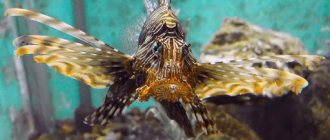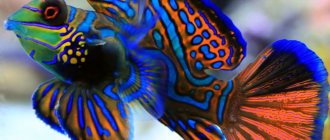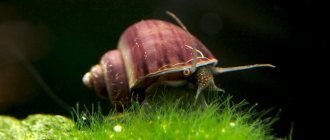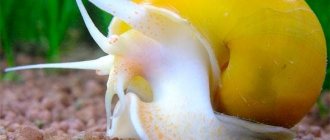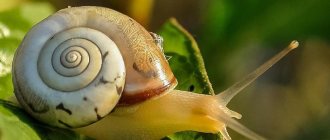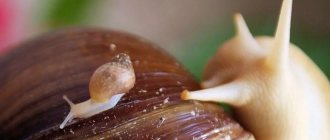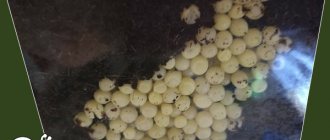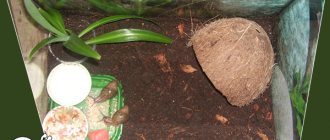Snails, or gastropods, are the most numerous class of mollusks, numbering more than 100 thousand species. A common characteristic feature for all varieties of the class is the presence of an external shell, the size of which allows all the soft parts of the body to be hidden inside.
It is believed that the name “snail” comes from the Proto-Slavic word “hollow”. Due to its relatively small size and special body structure, the question often arises: is a snail an animal or an insect? In the biological classification, all varieties of snails are classified as mollusks, which, in turn, belong to the animal kingdom.
Description and general characteristics of the snail
Tiara
Initially, gastropods were adapted to life in salt water. In the process of evolution, numerous species have appeared living in freshwater bodies and on land. Currently, all representatives of the class are divided into three main groups:
| Group | Habitats |
| Land snails | They lead a terrestrial lifestyle, preferring places with high levels of humidity. Land-dwelling species breathe air. |
| Water snails | Marine, lake and river mollusks that receive oxygen by passing water through their gills. |
| Pulmonary snails | They can be found on land and in water, periodically rising to the surface to breathe. |
The anatomy of gastropods has the following features:
- The main characteristic of snails is torsion. This is called turning the internal sac 180 degrees.
- The nervous system is of a scattered-nodular type. The brain and most of the elements of the system are located in the front of the body.
- The digestive system includes the mouth, crop, stomach, and digestive gland. Due to torsion, the anus is located in the anterior part of the shell.
- Most species have only one kidney.
What does it look like
Grape snail
The external structure of the snail includes:
- Carapace . It is an exoskeleton that is shaped like a cone, spiral, or coil. The shell consists of several organic layers covered with a durable outer layer of calcium carbonate. Mollusks without shells are called slugs.
- head is horned due to two pairs of tentacles located on the head. The two long horns are the eyes (at the ends there are eye spots), and the two shorter ones are the olfactory organs. Mollusks see poorly and use their sense of smell and touch primarily for orientation.
- Leg . The main part of the body expands downward, forming the so-called ventral foot.
Sadovaya
How fast does a snail move?
There is a generally accepted belief that mollusks are the slowest creatures. How fair is this?
Snails move thanks to muscle contractions of the leg. In this case, intensive secretion of secretion from the mucous gland occurs. Mucus allows you to crawl faster on horizontal surfaces and provides reliable grip on surfaces when moving vertically.
Some snails move by crawling, others tear off part of their leg, alternately transferring the center of gravity from the front to the back and vice versa, resembling a caterpillar.
The speed of a gastropod depends on the method of movement, species, and living conditions. Thus, amber snails cover only 1-2 cm per minute, grape snails - 7 cm, trumpeter snails - 16 cm. Mollusks living in rivers and seas are capable of developing much higher speeds than their land-based relatives. The fastest of the snails is the sea butterfly. It is capable of speeds of up to 12 m per minute thanks to two wing-like blades formed during the transformation of the leg.
Types of snails
Neretina
The taxonomy of gastropods is periodically revised with the emergence of new data on the origin and development features of representatives of the class. The latest version of the classification appeared in November 2021.
Below are short descriptions of the most common and interesting gastropod species:
- Grape snail . A medium-sized mollusk with a deep brown shell. Found in most European countries. Meat and caviar are considered a delicacy.
- Reel _ A freshwater aquatic snail that grows to a size of 1-3 cm. The surface of the shell is painted red. Coils are placed in aquariums to remove plaque on the walls and eat dead algae.
- Garden snail. A terrestrial herbivorous mollusk with a light brown shell. It is a pest because it destroys young shoots and fruits of many garden crops.
- Neretina . The mollusk is native to the African continent. The shell grows up to 3-4 cm in diameter and has several color options: brindle, olive, striped. These are common domestic snails that become a real decorative addition to the aquarium.
- Akhatina . The largest land mollusks with a conical shell that has a wide variety of shades. In regions with a temperate climate, it is suitable only for home breeding.
- Luzhanka . A small freshwater mollusk with a brownish-red or brownish-brown shell. Belongs to viviparous species. Distributed in the southern regions of the European continent.
- Forest snail (chain snail). The most common species in Europe. You can identify it by its yellow shell with black stripes.
- Ampularia . An unpretentious aquarium snail native to South America. In favorable conditions it can grow up to 10 cm in length.
- Bitinia . Lives in Europe, Asia and North America. The conical shell is painted dark brown. More than 20 subspecies of the mollusk are known.
- Tiara . An aquarium mollusk with small, needle-like hairs growing on its shell. The hairy snail reaches a length of 2-3 cm and has a yellow or cream color.
Achatina
Ampullaria sp. Pigeon blue
Blue ampularia is a selectively bred form of mollusk. The natural form of ampularia lives in the reservoirs of Brazil. These snails belong to the family of the same name. Blue ampularia grow up to 6-8 cm and look attractive in a home aquarium! Color ranges from pale blue to grayish. Ampoules can nibble on plants, so they need to be fed with plant products (cucumbers, zucchini, lettuce). Adult ampullaria eat quite a lot and excrete a lot of metabolic products, so the aquarium with them should be equipped with a filtration system. They live in an aquarium for about 2 years.
Habitat
The lifestyle of snails and the ability to adapt to different living conditions have allowed them to spread almost throughout the world, with the exception of polar and arid desert regions. In nature, the greatest diversity of species is represented in the tropical and subtropical zones.
Luzhanka
Mountain and grape snails are grown artificially on special farms for subsequent consumption and production of cosmetics.
Location
The habitat of snails is scattered throughout the globe. They live in both temperate and hot climates.
The only places where snails are not found are areas covered with ice and waterless deserts. The main criterion for choosing their habitat is high humidity.How long do snails live?
forest chain
The average lifespan of most gastropods is 4-5 years. Some land species live up to 8-10 years. The real long-livers among their relatives are the megas and the grape snail: in favorable conditions, some individuals are able to live up to 15-20 years.
SQUIRREL
How to determine the age of a snail
Ampoules
Mollusks change their appearance depending on the stage of development. First of all, when determining age, you should focus on the size of the shell and the number of turns in it. In some species, the reproductive organ becomes visible after puberty. You can find information that older individuals change their taste preferences or shell color. All known methods make it possible to establish the age of a mollusk only approximately. It is impossible to know exactly the number of years a snail has lived.
Arrangement of the terrarium
How to care for garden snails in captivity? First of all, they need soil to hide in if necessary. The humidity of the substrate should be such that no water comes out when pressing on it.
It is better to use soil from the place where the snail was taken. The layer of soil not treated with pesticides should be sufficient for the mollusk to burrow completely into it.
Flower soil is not suitable for creating a terrarium substrate. It contains chemical additives that are harmful to shellfish.
Sphagnum moss, vermiculite, compost or peat work well as a soil covering. They absorb and retain moisture well, which prevents the substrate from drying out. Such conditions for keeping garden snails are as close to natural as possible, which contributes to their normal life.
An untreated snag or branch placed in a terrarium will greatly help a garden snail feel “at home.” The mollusk will always be able to find shelter under it if it senses danger. He also likes to hide in damp fallen leaves and spends most of his time in such a “shelter”.
Don't forget to put a lid on the terrarium. A wild garden snail is no less inquisitive than a domestic one, so it quickly crawls out of any uncovered container. The impact of a fall on the floor often results in chips and cracks in the sink.
How do snails winter in nature?
Most species of land snails that live in regions with seasonally low temperatures hibernate during the winter months. Wintering can begin as early as October and ends in April with the arrival of stable heat.
Before the start of the rest period, animals feed heavily, gaining weight and stocking up on nutrients. Next, the mollusks begin to prepare a place for wintering. Typically, shelter is provided by holes covered with leaves, or specially dug holes. During sleep, the snail seals the entrance to the shell with a mucus plug - the epiphragm.
During wintering, the mollusk's metabolic processes slow down, and the chemical composition of the hemolymph and intracellular fluid changes. This makes it possible to avoid frostbite and survive the cold, using the nutrients accumulated in the fall.
Some species may hibernate during drought or lack of food supply.
How do snails reproduce?
The vast majority of gastropods are oviparous animals. Aquatic mollusks are heterosexual, while land mollusks are predominantly hermaphrodites. Snail reproduction occurs as follows:
- Before laying, eggs are placed in durable capsules;
- all capsules are placed in pre-dug holes, and the number of eggs in one clutch can reach several dozen;
- By the time the larvae mature, the capsule lids dissolve.
Snails are born with a transparent shell, which grows with the body and gradually changes color and becomes more durable.
Among the mollusks there are viviparous species, for example, lemon Achatina and Achatina Kraveni.
What benefits do snails bring?
Bitinia
Gastropods secrete several types of mucus. The most valuable in terms of chemical composition is the one that snails produce during stress or damage to the shell. The properties of this mucus are widely used in cosmetology: creams, masks, and balms are made from it to moisturize and rejuvenate the skin.
JELLYFISH
Advantages
In small quantities, snails can be useful for the aquarist. Many of them feed on carrion, eat algae and detritus, which help to some extent clean the aquarium (you should not try to delegate all the work of maintaining the aquarium to snails - this is still your task), and some species, for example, the Malaysian sand melania, due to their habit dig into the ground in search of food, turn over the soil granules, which prevents it from caking and the formation of hydrogen sulfate, which is toxic to fish in large quantities.
Sometimes aquarists specifically add certain types of snails to the aquarium, either for the reason mentioned above, or simply because snails can also be an interesting and colorful addition and decoration to the aquarium.
What do snails eat?
The diet of mollusks largely depends on the species and habitat. Land species eat mainly plant foods: grass, leaves, soft fruits of trees and shrubs. When there is a lack of food supply, they consume decaying vegetation.
There are predators among sea and river snails. Their food includes insects, worms, fish eggs, and shellfish. Some predatory species are capable of releasing a poisonous secretion that paralyzes fry and small fish.
The food of a snail kept at home may consist of cabbage and lettuce leaves, other vegetables and fruits. Mollusks living in aquariums eat algae and fish food.
How many teeth does a snail have?
Gastropods feed mainly on solid food, chewing it with the help of microscopic chitinous teeth - radulas. They can only be seen with significant magnification. In appearance, radulas resemble curved fangs.
As they wear down, new teeth grow on the chitinous film covering the mouth. Their number in different representatives of the class varies from 5 to 25 thousand pieces, while the most dense and durable teeth grow in predators.
Gastropod nutrition
The diet of mollusks is varied and depends on the place of residence. Young individuals prefer fresh plant foods (grape and cabbage leaves, cucumbers, carrots, strawberries, etc.); with age, food preferences may change, and they may begin to eat meat and mushrooms.
Some species prefer to eat carrion. Oddly enough, there are also predatory species that eat various crustaceans and small relatives, as well as various insects.
Marine species (geographical cone) eat fish, using paralyzing poison to neutralize them.
Who eats snails
In their natural habitat, snails' enemies are birds (starlings, jays, chickens, guinea fowl) and predatory fish. They are also eaten by some species of omnivorous mammals: hedgehogs, raccoons, moles. In South and North America, mollusks become food for snail eaters - snakes from the colubrid family.
AXOLOTL
Helena (Anentome helena)
A predatory snail that feeds on its relatives. In nature, Helenas live in the regions of Asia. They are interesting in appearance: an elongated shell, contrasting alternation of yellow and black stripes.
Helenas are effective helpers in the fight against unwanted snails (melania, coils). This is exactly why they won the love of aquarists! These snails do not touch plants, feeding mainly on protein foods. They eat catfish tablets with pleasure. Helenas grow about 2 cm and live for about 2 years.
Interesting facts about snails
- The mucus secreted by snails contains the following substances: a powerful skin regenerator allantoin, collagen and elastin that maintain the elasticity of the skin, glycolic acid, and vitamins. After using products based on the secretion of mollusks, a natural filter is created on the surface of the skin that does not transmit ultraviolet radiation.
- The largest land snail in the world is the African giant Achatina, weighing 900 grams. The animal had a length of 39.3 cm, the diameter of the shell was 23.7 cm. Among marine gastropods, the Australian trumpeter is distinguished by its gigantic size. The weight of some specimens reaches 15-18 kg.
- The tropical viviparous tree snail, which lives on the island of Moorea, is recognized as the rarest endangered species and is listed in the international Red Book. Currently, only a few small colonies of these mollusks have been found in their natural habitat.
- The conus snail is the most poisonous snail, the toxins of which pose a danger to humans. The species is found in seas belonging to the Pacific and Indian oceans.
Useful material
Biologists have calculated that the average snail is 80% water, 15% protein and 2.4% healthy fat. In particular, the meat of these shellfish contains essential fatty acids, calcium, iron, selenium, and magnesium. They are rich sources of vitamins A, E, K and B12.
Snails are an ideal option for a fat-burning diet. The calorie content of a 100-gram serving does not exceed 90 kcal. At the same time, the delicacy will provide the maximum amount of proteins (approximately 16.5 g) and the minimum dose of carbohydrates (no more than 2 g).
Regarding fats, nutritionists have calculated that a serving of gastropods contains less than 2 g of fat. But the main advantage is not even this, but the high content of omega-3 fatty acids. For example, snails contain eicosapentaenoic acid (almost 120 mg per 100 g of product), which is one of the main components of omega-3. Cardiologists recommend consuming 250 mg of fatty acids from shellfish daily to reduce the risk of cardiovascular disease.
If we talk about the vitamin and mineral composition, then 100 g of snails is:
- 3.5 mg of iron (which is more than in beef);
- 250 mg magnesium (which is much more than in beef, pork, chicken or fish);
- 382 mg potassium;
- 272 mg phosphorus;
- 70 mg sodium;
- 10 mg calcium;
- 1 mg zinc;
- 0.4 mg copper;
- 27.5 mcg selenium;
- 0.5 mcg vitamin B12;
- 0.1 mg vitamin B6;
- 100 IU vitamin A;
- 5 mg vitamin E;
- 0.1 mcg vitamin K;
- 0.1 mg riboflavin;
- 1.4 mg niacin;
- 6 mcg folic acid;
- 65 mg choline.



